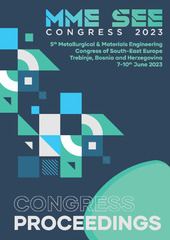Приказ основних података о документу
Preparation and characterization of chitosan–clay composites as potential drug carriers
| dc.contributor | Sokić, Miroslav | |
| dc.contributor | Marković, Branislav | |
| dc.contributor | Manojlović, Vaso | |
| dc.creator | Krajišnik, Danina | |
| dc.creator | Uskoković-Marković, Snežana | |
| dc.creator | Daković, Aleksandra | |
| dc.creator | Smiljanić, Danijela | |
| dc.creator | Kozarski, Maja | |
| dc.creator | Lazić, Vesna | |
| dc.date.accessioned | 2023-09-05T08:29:42Z | |
| dc.date.available | 2023-09-05T08:29:42Z | |
| dc.date.issued | 2023 | |
| dc.identifier.isbn | 978-86-87183-32-2 | |
| dc.identifier.uri | https://ritnms.itnms.ac.rs/handle/123456789/721 | |
| dc.description.abstract | In this study, the preparation and characterization of chitosan–clay composites as potential carriers for tetracycline were performed. The composites based on bentonite (from the deposit of Beretnica, Republic of Serbia) and chitosan were prepared. Two types of chitosan were used for the preparation of the composites: commercial low molecular weight chitosan and chitosan isolated from fruit bodies of the commercially grown mushroom Agaricus bisporus. Adsorption of tetracycline hydrochloride onto natural clay and chitosan-clay composites from aqueous media (pH 3.4) was studied. The amounts of adsorbed antibiotic were determined spectrophotometrically from the difference between the initial concentrations of tetracycline and the amounts remaining in the aqueous medium after dynamic equilibrium. Characterization of the natural clay and chitosan-clay composites before and after adsorption of tetracycline was performed by zeta potential measurements. Adsorption of tetracycline followed a nonlinear isotherm for the natural clay and composites. The Langmuir equation showed the best fit of the equilibrium adsorption data over the entire concentration range (0.05 – 1 mg/mL) and themaximum adsorbed amount of the drug on the natural clay and both chitosan-clay composites was up to ~ 200 mg/g. Only minor differences in the adsorption of the drug were observed between the composites containing commercial chitosan and the chitosan isolated from mushrooms. The observed decrease in zeta potentials of the drug chitosan–clay complexes revealed the interactions of the composite surface with tetracycline molecules. The obtained results indicate the potential of the chitosan-clay composites for the development of therapeutic systems for topical application and suggest the possibility of using fungi as a renewable source of chitosan. | sr |
| dc.language.iso | en | sr |
| dc.publisher | Belgrade : Association of Metallurgical Engineers of Serbia | sr |
| dc.relation | info:eu-repo/grantAgreement/ScienceFundRS/Ideje/7748088/RS// | sr |
| dc.rights | openAccess | sr |
| dc.source | 5th Metallurgical & Materials Engineering Congress of South-East Europe | sr |
| dc.subject | clay | sr |
| dc.subject | chitosan | sr |
| dc.subject | composites | sr |
| dc.subject | drug carriers | sr |
| dc.subject | tetracycline | sr |
| dc.title | Preparation and characterization of chitosan–clay composites as potential drug carriers | sr |
| dc.type | conferenceObject | sr |
| dc.rights.license | ARR | sr |
| dc.citation.epage | 127 | |
| dc.citation.spage | 123 | |
| dc.identifier.fulltext | http://ritnms.itnms.ac.rs/bitstream/id/1195/bitstream_1195.pdf | |
| dc.type.version | publishedVersion | sr |

